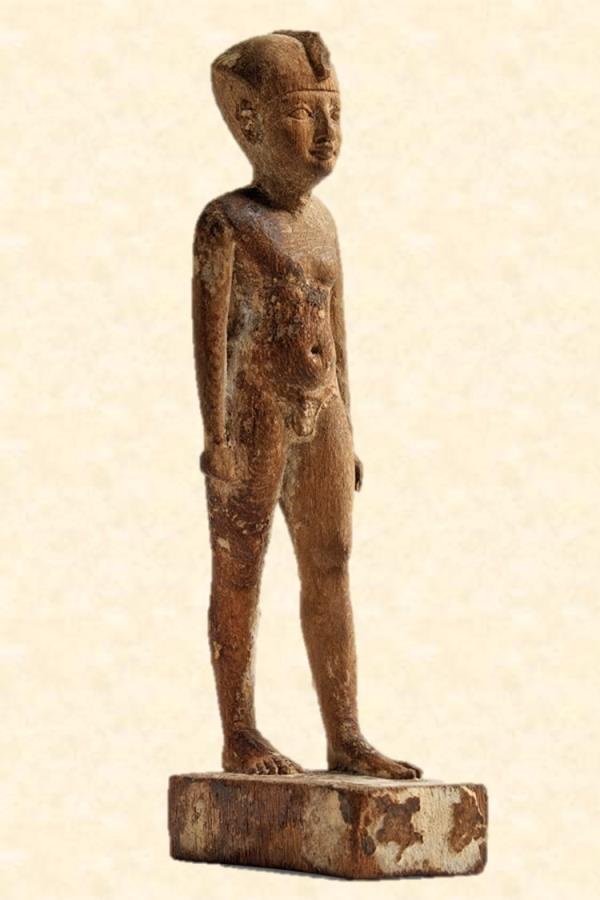
Ancient Egyptian Religion: Horus the Child

Figure 1.--This is another statuette depicting Horus as a child. These images became very popular among all classes of people. Only wealthy individuals could afford a bronze image. This is a wooden image, probably dating to the 4th century BC. This would have been an image even the poor could have afforded. Notice the hand is not raised to the lips. This would have been more complicated to carve.
|
|
Egyptian kings or pharaohs were seen as gods by the common people. The pharoh was in fact the god's representatives on earth, most commomly Horus. Egypt had an exotic pantheon of gods. One of the most important was Horus who is easily recognized because he is often depicted with a falcon head. It was the rituals and religious ceremonies overseen by pharaoh and the priests guaranteed the continuation of Egyptian civilization and indeed life itself. He is the god most closely associated with pharoh and kingship.
Another depiction of Horus is the child Horus as we see here (figure 1). Horus the child was also known as Harseisis or HerusaAset--meaning Horus son of Isis. He was also known as and Harpokrates or Herupakhered (meaning Horus the Child or Horus the Younger).
Horus was the son of Isis and Osiris. He was inpriobably concieved after the death of Osiris at the hands of Set. He was this brought up in secret by Isis to hide hiom from Set. And then as an adult took up his gather's bsttle against Set. As Harseisis or the other Horus child names, he was invariablr depicted with the side locks and naked. Both were commion for children. He also usually had one finger held to his lips. This was to reopresent childhood because the size of figures in Egyptian art did not always represent age. Harseisis might represent both the royal heir and the sun about to rise. He is depicted alone and his mother Isis.
The images of Horus Child became very popular and probably there were for all condition people. A bronze like this one would only be owned by a rich person, but we see less expensive images done in wood a clay. In fact, Horus is the Egyptian god most commonly depicted as a child. These reprresenations are of interest to HBC because they depict thge hair style for children as well as the fact that many children did not wear clothes. The younger Horus was sometimes mentioned as related to the older god, but over time began to eclipsed him in the minds of nany Egyptians and came to acqyuired many of his powsers. By Ptolemaic times (323-30 BC), the adult Horus had been virtually replaced by the child Horus. These respresentation could also represent the heir. There are also important relgious issues which have impacted Western civilization. But in Egyptian religious practice was was part of Isis and Osiris and the struggke with Set--essentially the cosmic struggle between good and evil. More importantly to the modern world was the Isis cult in the Roman world which competed with and infuenced Christianity. The child Horus was by many seen to epresent a promise by the gods care forvsuffering humanity. He had suffered greatly as a child. And thus knew how it felt to be both vuknerable and exposed to danger. [Pinch, p. 147/] This was the form of Horus that would become known to the classical world--the Greek Harpocrates. Plutarch referred to him as 'the second son of Isis' and the Isus mystery cult rached Rome (2nd cenbtury BC). The Cult of Isis was the most popular mystery cult in Rome, greatly influencing the development of Christianity Simolarities cabn ve seen with baby Jdesus and the Virgin Mary and son. Harpocrates was the divine son commonlh depicted in ancient Roman art with his mother. Some authors believe ghat this influenced the iconic image of the Virgin Mary and baby Jesus in Christian art.
Sources
Pinch, Geraldine. Egyptian Mythology: A Guide to the Gods, Goddesses, and Traditions of Ancient Egypt (Oxford University Press: 2004).
HBC

Navigate the Historic Boys' Clothing Web Site:
[Return to the Main ancient Egyptian religion page]
[Return to the Main ancient Egyptian page]
[Return to the Main religion page]
[Introduction]
[Activities]
[Art chronologies]
[Biographies]
[Countries]
[Photography]
[Style Index]
[Bibliographies]
[Contributions]
[FAQs]
[Glossaries]
[Images]
[Links]
[Registration]
[Tools]
[Boys' Clothing Home]
Created: 8:37 PM 9/22/2020
Last updated: 8:37 PM 9/22/2020



